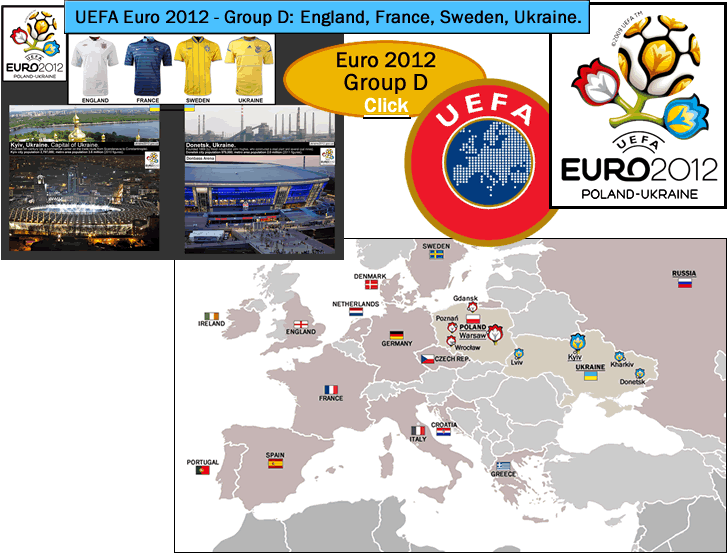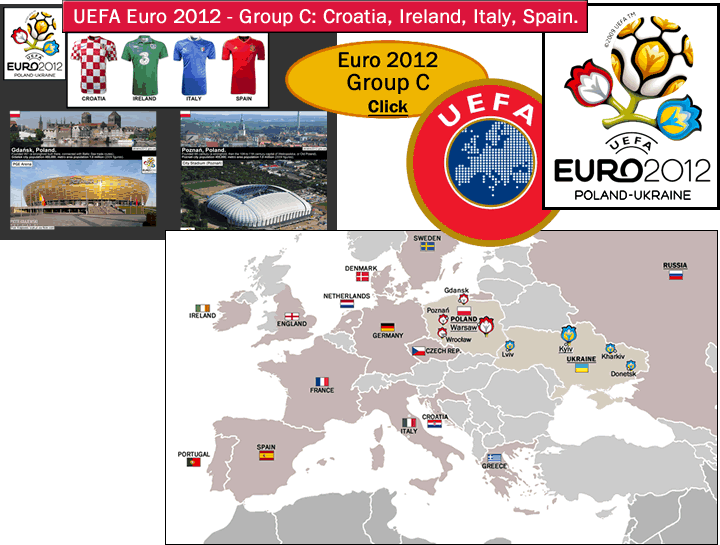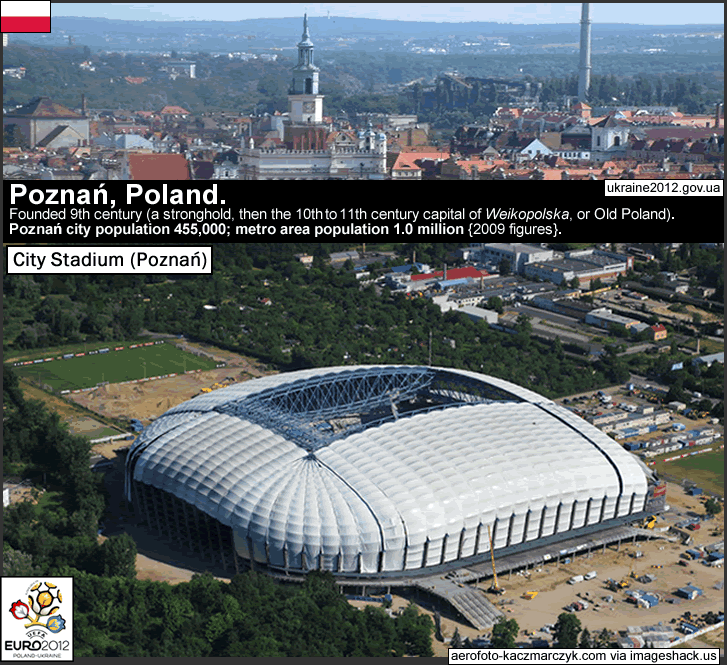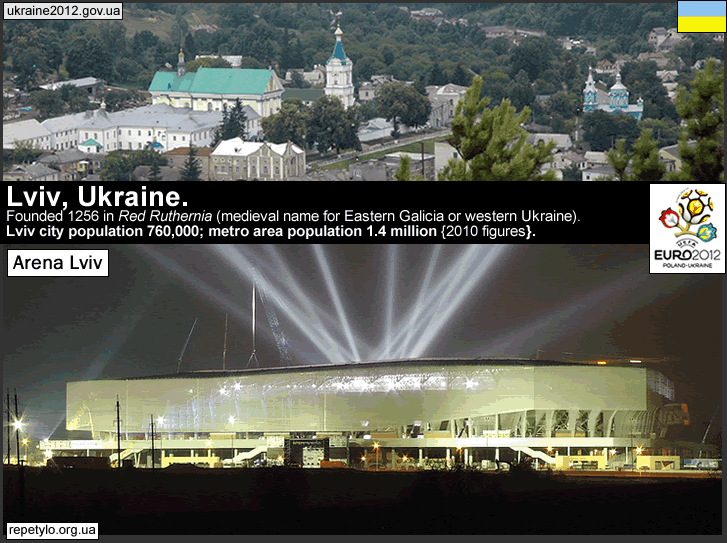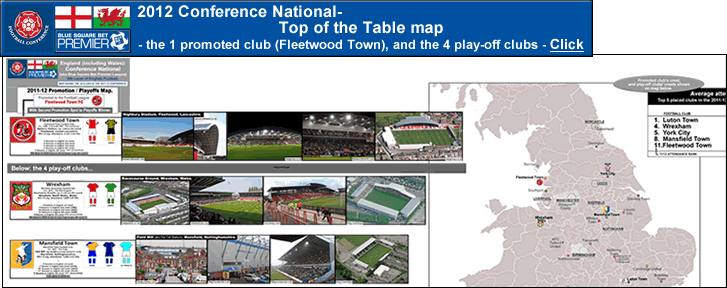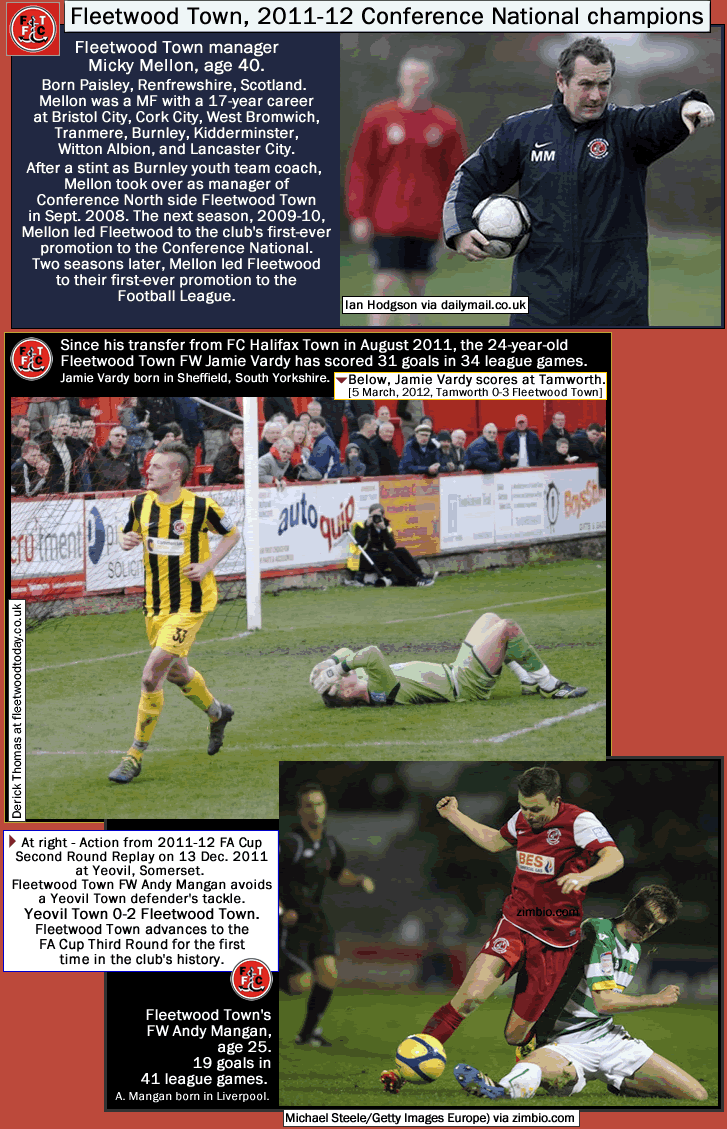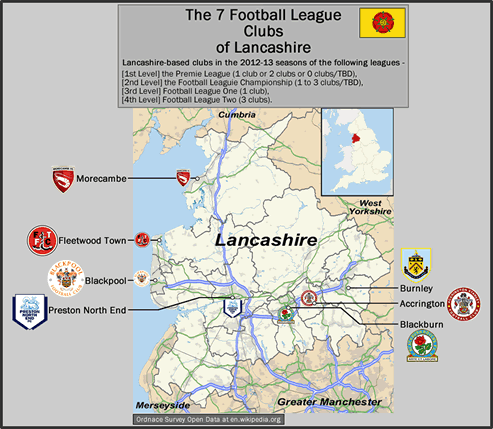
2012 Brasileiro map and titles list
The 2012 Campeonato Brasileiro Série A is the 42nd season of Brazil’s Campeonato Brasileiro Série A. Reigning champions are São Paulo-based SC Corinthians Paulista. 2012 will be the ninth season that the 20-team Campeonato Brasileiro Série A is using the standard round-robin format of home-and-away-matches-versus-all-other-clubs (for a 38-game season), as well as a basic relegation format (with the bottom 4 finishers going down to Série B, while the top 4 finishers from Série B win promotion). The season starts on Saturday 19 May.
Campeonato Brasileiro Série A – Fixtures, Results, Table (soccerway.com).
But while the format of top flight Brazilian football has come in line with most of the professional football leagues throughout Europe and the rest of South America, their calendar has not. Starting their season in May really puts Brazilian clubs at a disadvantage. The reason Brazil’s national football league starts in mid-May is the continued existence of the outmoded state championships – an anachronism that is of a time when infrastructure and transportation in Brazil could not accommodate a nation-wide first division league, so the state championships were necessary, and served a role in Brazilian football. ‘Brazilian football state championships‘ (en.wikipedia.org). But since the early 1970s, there has been a national league, so state championships should have become redundant. Yet the poorly-attended and now pretty much pointless state championships persist. Why? Because of entrenched power interests in all of the 26 state football associations. If these now-irrelevant cup-format state championships were phased out, those old white guys in positions of power in every state football association in Brazil would lose their power, prestige and cushy jobs – they would lose their gravy train. And so, like parasites, the guys in power in the football associations in all the states in Brazil conspire to maintain the state championships. And so the state championships continue to take up a significant and pivotal portion of the calendar year (from January to mid-May), which thus sucks time and energy and media attention away from the important thing that all the millions of pro football fans in Brazil care about – the Brasileiro – and keeps Brazil out of the loop, literally. Due to the Brazilian league starting in May, as opposed to August, clubs’ transfer policies, budgets, and roster decisions are thrown out of whack. And Brazilian clubs still alive in the Copa Libertadores each year are also hampered by the domestic season’s opening in May, because they are forced to start the new season while concentrating on their Quarterfinals and Semifinals matches in the Copa Libertadores.
There are 4 Brazilian clubs still alive in the 2012 Copa Libertadores – Fluminense (who square off against Boca Juniors), Corinthians and Vasco da Gama (who face each other), and Cup-holders Santos (who play Vélez Sársfield).
‘2012 Copa Libertadores/ Quarterfinals‘ (en.wikipedia.org).
…
Brazilian Pro Football titles chart
The map page has a different layout from previous maps I’ve done for Brazilian football. On this one, the emphasis is on the titles won by clubs.
At the far left of the map page there is a location-map of the 20 clubs in 2012 Brazilian first division. The center and right-hand side of the map page is taken up by a chart which lists the national, state, Copa do Brasil, and Copa Libertadores titles of 24 clubs. The clubs are listed by 2011 average attendance (from home league matches in either Série A or Série B).
Also listed in the chart, near the center, are consecutive seasons in the Brazilian top flight by club. [Note: there are 5 clubs in Brazil that have spent all 42 seasons in the Brazilian first division - Cruzeiro, Flamengo, Internacional, Santos, and São Paulo.].
The 4 newly-promoted clubs for 2012 are listed at the bottom of the chart. Those 4 newly-promoted clubs are – Náutico, Ponte Preta, Portuguesa, and Sport Recife.
The first note I should make is that the chart has 24 clubs in it because it also includes the 4 clubs relegated out of Série A after last season – América (Minas Gerais), Atlético Paranaense, Avaí, and Ceará. You can tell which clubs are the relegated clubs by their lack of bold-face text in the far left column [2011], and by their lack of inclusion in the green column at the far right [2012].
National titles listed are – Campeonato Brasileiro Série A titles (from 1971 to 2011), plus Taça Brasil titles (1959-68), plus Torneio Roberto Gomes Pedrosa titles (1967–70) [see 3 paragraphs down].
On the chart, national titles are listed in the dark blue column at the center-right-hand side of the chart. Along the entire lower section of the map page are the crests of all clubs with national titles in Brazil, going from left to right in descending order.
I have included, among national titles won, the titles won from the generally accepted precursor to the modern Brazilian national championship competition, which was called the Taça Brasil. The Taça Brasil was founded in 1959 to enable Brazil to provide contenders for the newly-created Copa Libertadores, which had it’s inaugural season in 1960. Here is the Wikipedia page of Taça Brasil. The successor to the Taça Brasil was the Torneo Roberto Gomes Pedrosa (1967–70), which had originally been the Torneo Rio-São Paulo, for clubs only from Rio de Janeiro state and São Paulo state. In 1967, the tournament was opened to include clubs from Minas Gerais, Paraná and Rio Grande do Sul states, and later also from Pernambuco and Bahia states. In 1969 and 1970, the winner and the runners-up in the Torneio Roberto Gomes Pedrosa went to the Copa Liberadores. Palmeiras won it in 1969, and Fluminense won it in 1970. In 1971, the Campeonato Brasileiro Série A was established, and the inaugural season was won by Clube Atlético Mineiro, a Belo Horizonte-based club that has never won the title again. Palmeiras won the Brazilian title in the second and third seasons of the Brasileiro (in 1972 and 1973). Vasco da Gama won the title in 1974, and SC Internacional won the Brasileiro in 1975 and 1976. To round out the first decade in Brazil’s national league, São Paulo won the title for the first time n 1977, current-second-division club Guaraní won the title in 1978, SC International were champions again in 1979, and Flamengo won it for the first time in 1980. As far as the all-time titles leader in Brazil goes, it depends on how you define the title. If you count Taça Brasil titles and Torneo Roberto Gomes Pedrosa titles (1959-1970) along with Campeonato Brasileiro Série A titles (1971-present), both Santos and Palmeiras have won the most Brazilian titles, with 8 titles (Santos won it last in 2004, and Palmeiras won it last in 1994). If you only count Campeonato Brasileiro Série A titles (from 1971 to present), Flamengo and São Paulo are tied with the most titles, with 6 titles each (Flamengo won it last in 2009, and São Paulo won it last in 2008).
‘List of Brazilian football championships‘ (en.wikipedia.org).
…
SC Corinthias – 2011 Brazilian champions
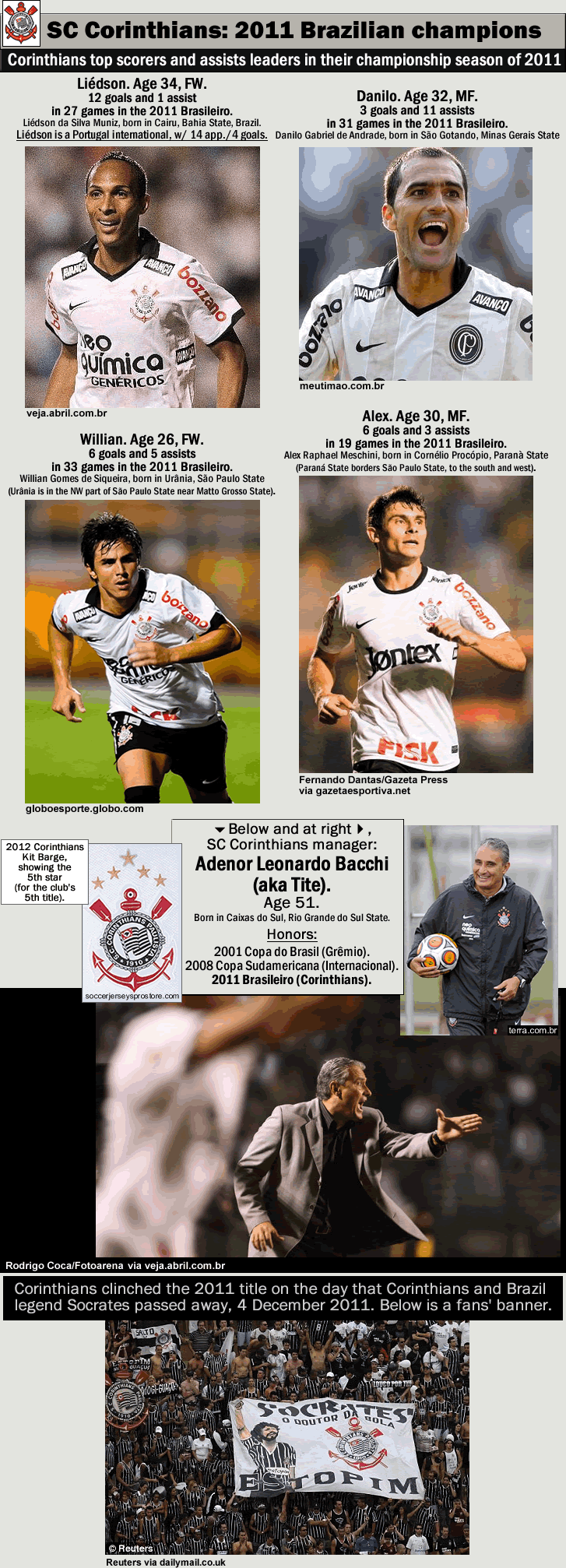
Photo credits above -
Liédson, (Rodrigo Coca/ Fotoarena) at veja.abril.com.br.
Danilo, meutimao.com.br.
Willian, globoesporte.globo.com.
Alex [Paranà], Fernando Dantas/Gazeta Press via gazetaesportiva.net.
Tite, Rodrigo Coca/Fotoarena via veja.abril.com.br; Tite smiling, terra.com.br/esportes/infograficos/santos-x-corinthians .
Banner for Socrates, Reuters via dailymail.co.uk/sport/football/article-2069960/Socrates-dead-Corinthians-win-Brazilian-title-fans-paty-tribute
…
From Pitch Invasion.com, from April 9 2010, by Jeremy Rueter, ‘WHAT’S IN A NAME? – SPORT CLUB CORINTHIANS PAULISTA‘.
Sport Club Corinthians Paulista, established 1910, São Paulo, Brazil.
SC Corinthians Paulista were named after the London, England-based Corinthian Football Club, which existed from 1882 to 1939, then had a merger to form Corinthian-Casuals FC (1939 to present). The resolutely amateur Corinthian FC toured Brazil in 1910, and a group of laborers in São Paulo were then inspired to form a football club. As opposed to most other established football clubs then in Brazil, SC Corinthians were to be open to all, not just the elite class of Brazilian society. Corinthians won their first São Paulo State title (Campeonato Paulista title) in their fifth season, in 1914 (see photo on chart below). Corinthians have won the most Campeonato Paulista titles, with 26 (last in 2009). Corinthians have won 5 Brazilian titles, their first in 1990, and their fifth in 2011. Their most prominent nickname is Timão (which translates as the Ship’s wheel). SC Corinthians are São Paulo’s most-supported club and have vast support throughout Brazil – Corinthians are generally regarded as the second-biggest club in Brazil, second only in support to the Rio de Janeiro giants Flamengo {see this poll from 2004 {‘Flamengo and Corinthians [lead the] survey of leading supporters in the country‘ (esporte.uol.com.br)}, and see this poll from 2008 {Ranking of the fans (globoesporte.globo.com)}. In 2011, Corinthians had the highest average attendance in Brazil (from home league matches), at 29,951 per game. They play at the São Paulo municipal stadium Pacaembu (aka Municipal Prefecture Stadium Paulo Machado de Carvalho), which has a 37,000 capacity. Corinthians share the stadium with local rival Palmeiras. Sometimes, when large turn-outs are expected, Corinthians play at local rival FC São Paolo’s Estádio do Morumbi (capacity, 67,000). New Corinthians Stadium, a new municipal stadium to be built for FIFA World Cup 2014 in Brazil, is planned to become the new home of Corinthians after 2014. {See this article from the Corinthians’ official site, with photos of the construction of the New Corinthians Stadium}. In recent years, some supporters of Brazil’s Corinthians make the journey to London, England to visit and support the still-amateur Corinthian-Casuals FC at their ground. Corinthian-Casuals FC are an 8th Level club in the Isthmian League Division One South. Corinthian-Casuals finished in 13th place in 2011-12, averaging 115 per game at their 2,700-capacity St. George’s Field in Tolworth, south-west London.
Click on image below for a small chart of Corinthians crests and kits through the years (1910 to 2012).
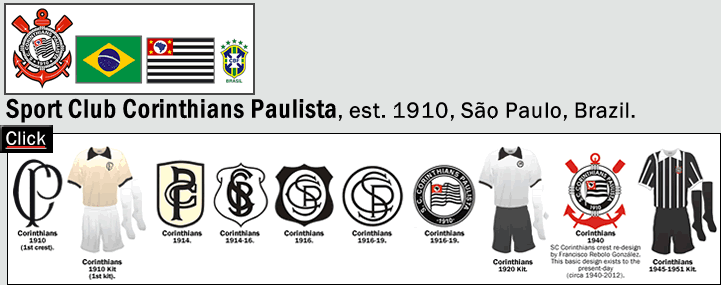
Image credits above –
Illustrations of old Corinthians kits (1910, 1920, 1955-51) by Lucas gc at en.wikipedia.org, ‘File:Evolução Uniforme Corinthians.png’.
Photo of 1914 SC Corinthians team from pt.wikipedia.org page on ‘Sport Club Corinthians Paulista‘.
Illustrations of old Corinthians kits (1951-54, ) by Bcav22 at pt.wikipedia.org, ‘Anexo:Evolução dos uniformes do Sport Club Corinthians Paulista‘.
Some of th old crests from seeklogo.com/tag.html?q=football.
2010/2011 Corinthians jerseys from football-shirts.co.uk/fans/corinthians-home-away-shirts-2011.
2010-11 kits from ‘Uniforms of Sport Club Corinthians Paulista‘ (pt.wikipedia.org).
2012 kits from ‘Sport Club Corinthians Paulista‘ (en.wikipedia.org).
2012 kit badge from soccerjerseysprostore.com/home-20112012-corinthians.
Photo of 2012 Corinthians 3rd jersey from football-marketing.com.
Here is an article about Corinthians’ crests and kits through the years, from globoesporte.globo.com, from August 2010, by Carlos Augusto Ferrari and Diego Ribeiro, ‘Do bege ao roxo, Timão conserva história com seu manto alvinegro [translated, 'Beige to purple, Timon keeps history with your mantle alvinegro']‘
Thanks to these sites for attendance figures, Worldfootball.net (Série A figures), Soccerway.com (Série B figures).
Thanks to Demis.nl/Web Map Server, for the base map of South America.
